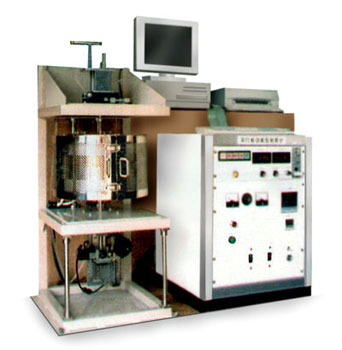Equipment Overview
A rotating cylinder viscometer is used to measure the low viscosity range of glass. In this method, a cylinder is immersed in a molten sample and the viscosity is determined by measuring the torque generated by rotating the inner or outer cylinder. In this case, a certain amount of sample is required, and the container for melting the sample and the furnace for melting the sample must be of a certain size. For example, when checking the temperature dependence of the viscosity of glass, the sample volume should be as small as possible and the heating furnace should be responsive to temperature rise and fall. Therefore, we adopted the parallel plate rotation method, which enables viscosity measurement with a small sample volume, and the furnace is as compact as possible. The viscosity is determined by rotating a small sample (about 0.5 ml) across the parallel plates and measuring the torque applied to the other plate.
(*References: Yutaka Shiraishi et al. Journal of the Japan Institute of Metals, Vol. 60, No. 2, 1996 184-194)

Features
- Small sample volume and therefore small temperature error.
- Measurement operation is easier than with the rotating cylinder method.
Viscosity measurement range
- 109-105 poise (parallel plate measurement)
- 104 to102 poise (rotational measurement)
| Equipment Configuration Dimensions | |
| Electric furnace | Shape: Vertical tubular type, split in two, open/close type |
| Furnace body dimensions: φ400×H265mm | |
| Inner dimensions of furnace: φ90×H200mm | |
| Maximum temperature: 1500°C | |
| Heater Capacity: 2.0kW | |
| Measuringsection | Dimensions: W450×D500×H1100mm |
| Torque sensor, desk rotation device | |
| Controlsection | Dimensions: W570×D470×H750mm |
| Temperature program controller, torque sensor amplifier | |
| PC system | PC, A4 printer, measurement operation and data processing software |
These specifications are subject to change for improvement.
Please feel free to contact us for more information about our glass testers!